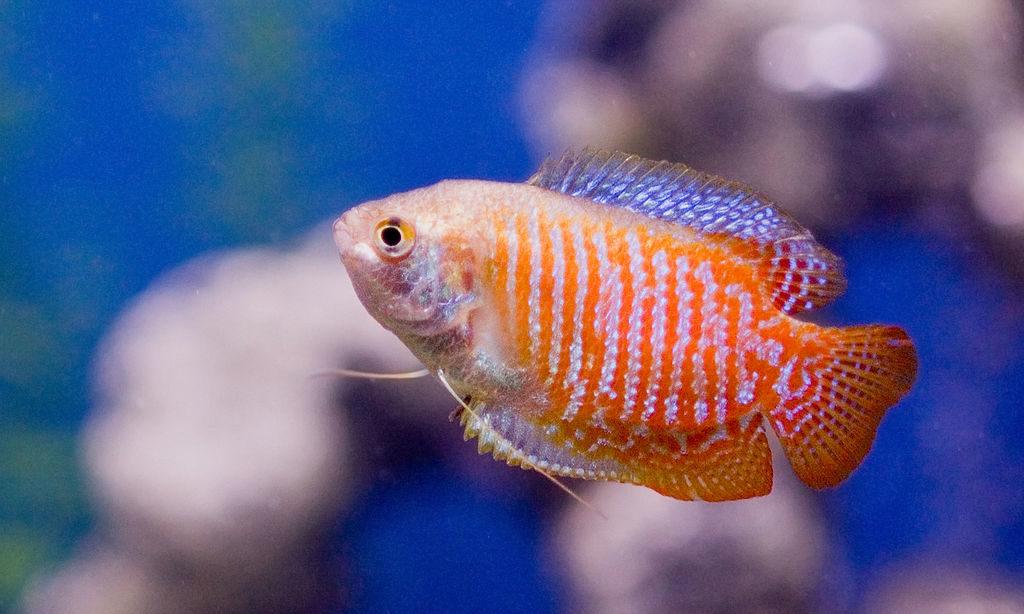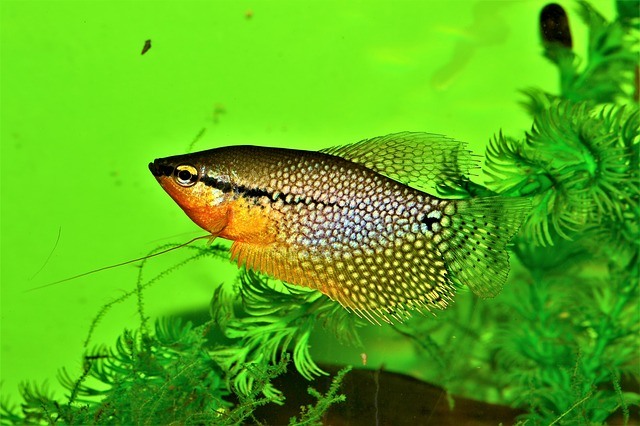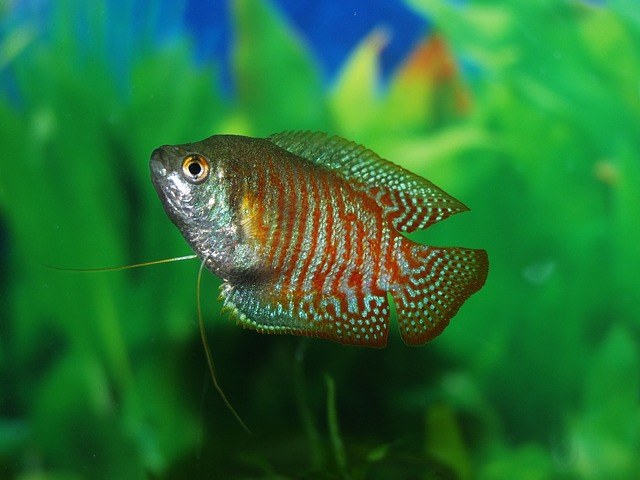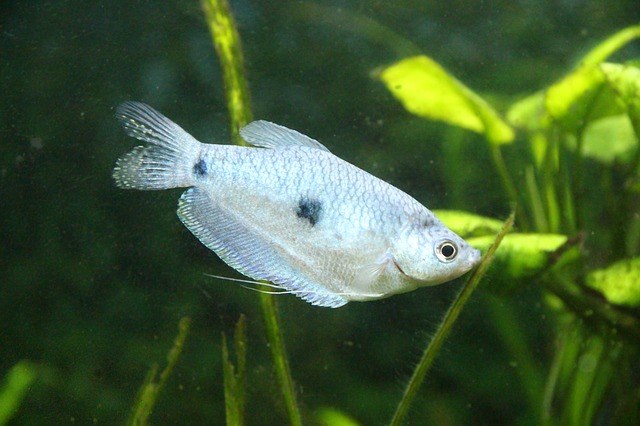If you’re looking for a fish that requires a bit more attention than your average goldfish and that can beautify your home or office tank, then you’ll have likely looked into the care and keeping of a dwarf gourami.
Dwarf gourami care does demand a bit of additional know-how, but the fish make excellent additions to a number of tanks, and their generally docile behavior – not to mention their elaborate mating rituals – makes them a pleasure to watch and attend to.
Before you bring these fish into your tank, however, you’ll want to consider a number of questions. Do you have the time to attend to a dwarf gourami’s health? Can you keep your fish’s tank as clean as it needs to be?
Likewise, you may have questions about the breed itself: Are gouramis hardy fish, for example, and how long can you keep them in your tank? How will the fish react if placed in a community tank?
All of these questions can and will be answered in this comprehensive guide to the gourami. Read on!
Contents
Dwarf Gourami: The Basics
Dwarf gourami have a vast nomenclature and are, as such, known by a variety of names. Some of these names refer to the fish’s coloring – such as the Red or Powder Blue dwarf gourami fish or the Neon Blue dwarf gourami.
They can otherwise be referred to, though, as Labyrinth fish referring to the breed’s possession of a labyrinth organ.
A labyrinth organ is a breathing organ with many folds that particular breeds of fish use in order to breathe air as well as take in oxygen from the water.
Labyrinth fish are not born with this organ fully developed, however, it grows as they age, becoming more usable only as they get older.
Young fry, as such, cannot survive outside of the water, whereas older dwarf gourami can, so long as they remain damp.
Appearance
Gourami are also unique in their coloring, standing out in a tank or among a school of other fish. Many of these colors developed when the fish were bred in captivity, but they are not a sign of harm, rather of genetic mutation.
The dwarf gourami’s original coloring gives the males a red or blue hue with females tending towards silver.
Male gourami also have diagonal stripes, and there are distinct differences between each gender’s dorsal fins that keepers can use in order to tell them apart.
Male gourami have pointed dorsal fins, whereas females have rounded dorsal fins.
Statistics
A quick overview of the dwarf gourami is enough to give you a general understanding of how they live, but learning how to care for the species takes more attention to detail than that.
Let’s get down to the details.
- Preferred pH levels: 6.0 – 7.5.
- Temperature Range: 72 degrees Fahrenheit to 82 degrees Fahrenheit.
- Water Hardness: 2-18 H.
- Average Size: 2 inches.
- Aquarium Size: A minimum of 10 gallons.
- Sensitivities: None.
- Diet: Omnivore.
Natural Habitat
Dwarf gouramis hail from South Asia, just like a number of other labyrinth fish. These fish can be found most often in Pakistan, India, and Bangladesh, where the waters are tropically warm.
This natural habitat brings lots of vegetation into the lives of the dwarf gouramis, allowing them a number of places to hide, as well as small nooks in which they can create safe territories.
Waters in these sorts of areas are home to slow-moving waters in the form of streams or lakes, making them all the safer for the dwarf gouramis, especially when this breed attempts to reproduce.
Additionally, it’s worth noting that the waters in which dwarf gourami and other labyrinth fish prefer to live have relatively low oxygen levels. As such, the fish have developed their labyrinth organ.
This evolutionary trait, developed so that the fish could live more effectively in the wild, does bring on a few stipulations when you opt to raise a breed like the dwarf gourami in captivity.
Gourami Care
Tank Requirements
Raising a single or a group of dwarf gourami in a tank requires particular attention, especially when you consider the tank’s initial set-up.
Dwarf gourami are known to live to about four years in captivity, but these fish can live longer if their tanks are well designed. As such, you’ll want to try and keep your gourami in a tank that is ten gallons or larger, adding another five gallons for every additional fish you introduce to the tank.
Dwarf gourami prefer to swim towards the top or middle of a tank, as well, so keep the bulk of your tank’s length on its horizontal access instead of a vertical one.
Additionally, you should leave an inch or so of air free of water at the top of your tank, so your fish can take sips of air over the course of a day.
Tank Set-Up
In addition to keeping an eye on how much water you place in the tank, you’ll also need to consider the amount of vegetation your tank holds, as well as the strength of its substrate.
Dwarf gourami, as mentioned, naturally live in environments with an excess of vegetation in which they can hide and establish small territories, not to mention create their bubble nests. As such, your ideal dwarf gourami tank will be heavily planted.
You should also include floating plants that can rest on top of the water. Your dwarf gourami will feel much safer swimming up and taking the air when they have foliage to hide beneath.
If you want to highlight your dwarf gouramis’ bright colors, you can install a darker substrate in your tank.
This darker coloring won’t disturb your fish, but it won’t mirror that of their natural habitat, either. It will instead serve as a neutral form of stimulation in the midst of your gouramis’ environment.
Water Requirements
Make sure that you change the water in your gouramis’ tank regularly. Gourami have especially delicate immune systems (as will be discussed in more detail below) so ensuring that their water is as fresh as possible will help prevent any water-borne illnesses from setting in.
In this way, dwarf gourami do require a bit more care than a different starter fish, but you’ll want to ensure that your fish live as comfortably as possible.
Finally, because dwarf gourami are especially sensitive to extra stimuli, do your best to set your tank away from loud areas.
Ensuring that your gourami have access to a peaceful environment outside of their tank will improve their health, as well as make your care and keeping of the fish all the easier.
Gourami Tankmates and Temperament
Dwarf gourami are especially peaceful fish, making them excellent in gourami community tanks.
They also pair well with mollies, tetras, and platies fish, as these equally docile species will not inspire many territorial feelings in the gourami.
While some sources claim that the dwarf gourami are shy and territorial, the majority agree that these fish thrive in community tanks, as they need the social interaction.
That said, it’s still not advisable to house a school of dwarf gourami. Keep your gourami in gendered pairs, instead, in order to avoid inspiring mating or territorial competition.
Feeding Gourami
When feeding your dwarf gourami, keep in mind that these fish are naturally omnivorous. As such, they can consume finely ground flakes or most forms of algae as well as brine shrimp, bloodworms, and tubifex.
Be sure to diversify your gouramis’ diet in order to keep the fish stimulated and to ensure that they receive all of the basic nutrients they need.
Gourami Breeding
You may be looking to breed your dwarf gourami, either to inspire a unique color of fish or to simply keep yourself flush with fishy companions. Either way, you’ll need to keep some of the following in mind.
When preparing to breed your dwarf gourami, establish a spawning tank that fits the general tank needs of the gourami.
Lower the level of water in the spawning tank to roughly eight inches during the spawning, however, and keep the water temperature towards the higher end of the species’ comfort scale.
The courting process between male and female gourami is rather amusing to watch, as it is a bit more involved than other fish.
The male will begin by swimming around the female with his fins flared, performing what appears to be a dance. If the female accepts his advances, she’ll begin to swim around him in circles, while he, in turn, will begin collecting bubbles.
Gourami are bubble nest builders, which means that after the fish go through their mating rituals, the male will protect the fertilized eggs with an array of bubbles.
As soon as spawning has completed (usually taking between two and four hours) you’ll want to remove the female gourami from the spawning tank.
The males will guard their eggs and help raise the fry for two to three days after they hatch, but after that point, you should move the male gouramis back to their normal tank as well.
Gourami Illness
It has been previously mentioned that the dwarf gouramis’ immune systems are not especially strong. While this does place its hardiness into question, it does not mean that the fish are not worthwhile pets.
It means that you, as a fish keeper, will be required to keep an eye out for symptoms of dwarf gourami iridovirus, or DGIV. This virus is exceptionally infectious and untreatable; it has a ninety percent mortality rate.
Symptoms of DGIV read similar to those of fish TB: your gouramis may start scabbing, or patches of scales on the head or body may begin to erode.
You’ll want to examine any gouramis for these sorts of symptoms before you bring them into your home, and in order to prevent the illness from taking hold of your fishy friends, you should pay the utmost attention to the quality of water in their tanks.
Here’s a video showing more details on gourami fish.
Do you have any tips for owning gourami?






